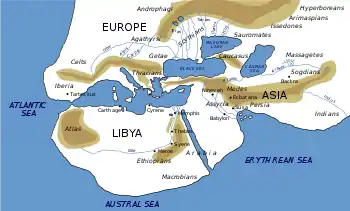Macrobians
The Macrobians (Μακροβίοι) was an ancient Proto-Somali tribal kingdom positioned in the Horn of Africa mentioned by Herodotus.[1] It is one of the legendary peoples postulated at the extremity of the known world (from the perspective of the Greeks), in this case in the extreme south, contrasting with the Hyperboreans in the extreme east.[2][3][4]

Accounts
According to Herodotus' account, the Persian Emperor Cambyses II upon his conquest of Egypt (525 BC) sent ambassadors to Macrobia, bringing luxury gifts for the Macrobian king to entice his submission. The Macrobian ruler, who was elected based at least in part on stature, replied instead with a challenge for his Persian counterpart in the form of an unstrung bow: if the Persians could manage to string it, they would have the right to invade his country; but until then, they should thank the gods that the Macrobians never decided to invade their empire.[3][5][6]
According to Herodotus, the Macrobians practiced an elaborate form of embalming. The Macrobians preserved the bodies of the dead by first extracting moisture from the corpses, then overlaying the bodies with a type of plaster, and finally decorating the exterior in vivid colors in order to imitate the deceased as realistically as possible. They then placed the body in a hollow crystal pillar, which they kept in their homes for a period of about a year.[7]
They were described to be a regional power house and in many respects a cultivated nation, remarkable for their size, beauty, physical vigour and longevity. A wealthy nation, living in cities with laws and institutions of their own governed by an elective monarch, who according to Herodotus must have met specific intellectual and physical requirements. They had markets, courts of justice and prisons; were skilled in the workings of metals, as well as in some of the fine arts [8] Macrobia was also noted for its gold, which was so plentiful that the Macrobians shackled their prisoners in golden chains.[5]
People
In the fifth Century BC, the Greek historian Herodotus, known as the father of History in the western traditions, refers to a race called the Macrobians who dwelled in the south of Ethiopia. These people were famous for their longevity (an average age of 120 years) due to their diet that mainly comprises meat and milk. They were also, according to Herodotus, the "tallest and most handsome among all men". They were fierce warrior herders and wealthy seafarers according to Herodotus again. All descriptions of the people agree with the pastoral Somali figures who are tall, handsome warriors, with a diet mainly consisting of meat and milk. Somalis also have a rich maritime culture. This point of view was affirmed by the Indian scholar, Mamta Agarwal, who wrote "these people were none other than the inhabitants of Somaliland, opposite the Red Sea.[9][10]
See also
- Greco-Roman ethnography
- History of Djibouti
- History of Somaliland
- Aithiopia
- Ancient Libya
- Sigelwara Land
- Fountain of Youth
References
- Herodotus, the Histories book 3.114
- The Geography of Herodotus: Illustrated from Modern Researches and Discoveries by James Talboys Wheeler pg 528.
- Wheeler pg 526
- Njoku, Raphael (2013). The History of Somalia. Greenwood. p. 47. ISBN 9780313378577.
- John Kitto, James Taylor, The popular cyclopædia of Biblical literature: condensed from the larger work, (Gould and Lincoln: 1856), p.302.
- White, John S. (2018-04-05). The Boys ́ and Girls ́ Herodotus. BoD – Books on Demand. ISBN 978-3-7326-5420-8.
- Society of Arts (Great Britain), Journal of the Society of Arts, Volume 26, (The Society: 1878), pp.912-913.
- The Edinburgh Review, Or Critical Journal: ... To Be Continued Quarterly, Volum 135 Page 101Archibald Constable, 1872
- Abdurahman, Abdillahi (18 September 2017). Making Sense of Somali History. Scarecrow Press. p. 47. ISBN 978-1-909112-79-7.
- Briggs, Phillip (2012). Somaliland. Bradt Travel Guides. p. 7. ISBN 9781841623719.
